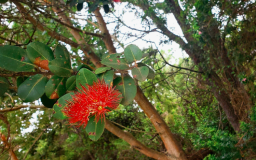

The Hawaiian Islands are home to a rich diversity of native flora, much of which is found nowhere else in the world. One of the most iconic and culturally significant trees among them is the Ōhiʻa Lehua tree. This tree not only holds deep cultural and spiritual importance in Hawaiian traditions but also plays a critical ecological role in native forests. Its vibrant red blossoms, resilience in harsh environments, and unique presence across different elevations make the Ōhiʻa Lehua tree a symbol of life, endurance, and natural beauty in Hawaii.
The Ōhiʻa Lehua tree is found throughout the Hawaiian Islands, particularly on the Big Island, Maui, Oʻahu, Kauaʻi, and Molokaʻi. Its presence is most dominant in native forests at elevations ranging from sea level to over 8,000 feet. The tree is incredibly versatile and can grow in various environments, including barren lava fields, lush rainforests, and cloud-covered mountaintops. The Ōhiʻa Lehua tree is often the first plant to colonize new lava flows, making it a pioneer species that paves the way for other plants to thrive in freshly formed volcanic soil. Its botanical name is Metrosideros polymorpha, and true to its name ("polymorpha" meaning "many forms"), it exhibits a wide variety of shapes and sizes—from shrubs to towering trees.
The importance of the Ōhiʻa Lehua tree extends beyond its ecological role. In Hawaiian mythology, the tree is linked to a poignant love story. According to legend, the handsome warrior Ōhiʻa was turned into a tree by the jealous volcano goddess Pele when he rejected her advances in favor of his lover, Lehua. The gods took pity on Lehua, who was heartbroken, and transformed her into the beautiful red blossom that now grows on the Ōhiʻa tree. It is said that if a Lehua flower is plucked from the tree, it will rain—representing the tears of the separated lovers. This story captures the deep spiritual connection native Hawaiians have with the natural world and particularly with the Ōhiʻa Lehua tree.
Ecologically, the Ōhiʻa Lehua is a keystone species in Hawaii’s native ecosystems. It provides habitat and food for numerous endemic species of birds, insects, and other plants. Native honeycreeper birds, such as the ʻApapane and ʻIʻiwi, feed on the nectar of its blossoms. The tree’s dense canopy also helps retain moisture in the soil, supporting a wide range of understory plants and fungi. Moreover, its roots are adept at stabilizing soil and preventing erosion, especially in mountainous and high-rainfall areas.
Despite its resilience, the Ōhiʻa Lehua tree faces significant threats. One of the most alarming is a fungal disease known as Rapid ʻŌhiʻa Death (ROD), caused by two species of fungi: Ceratocystis huliohia and Ceratocystis lukuohia. These fungi infect the tree through wounds in the bark and rapidly spread throughout the vascular system, eventually killing it. Since its discovery in 2014, ROD has devastated thousands of acres of native forest, particularly on the Big Island. This disease threatens not only the ecological balance of Hawaii's forests but also the cultural identity deeply rooted in the Ōhiʻa Lehua tree.
Efforts to combat Rapid ʻŌhiʻa Death include scientific research, public education, and policy measures. Local organizations and universities are studying the biology of the disease to understand how it spreads and how trees can be protected. Visitors and residents are advised not to transport wood or soil between locations to prevent the accidental spread of fungal spores. In addition, conservationists are collecting seeds and propagating young Ōhiʻa Lehua trees in nurseries to ensure the species' survival.
In terms of where to see the Ōhiʻa Lehua tree, the Hawaii Volcanoes National Park on the Big Island is one of the best places. There, the tree thrives amid hardened lava fields and along hiking trails such as the Kīlauea Iki Trail and Devastation Trail. The red lehua blossoms are especially visible during the blooming season from spring through early fall. Visitors to these areas are often struck by the contrast between the harsh black lava and the delicate, colorful blooms of the Ōhiʻa, which seem to embody the balance between destruction and renewal.
Cultural practices involving the Ōhiʻa Lehua tree continue today. Its flowers are used in traditional Hawaiian lei making, and the wood has historically been used in canoe building, tools, and house construction due to its hardness and resistance to decay. However, given the increasing threat of disease and deforestation, these uses are now approached with greater conservation awareness.
In conclusion, the Ōhiʻa Lehua tree is more than just a botanical species native to Hawaii—it is a powerful symbol of Hawaiian identity, resilience, and ecological health. Its presence across the islands is both a spiritual and environmental blessing, and its preservation is a shared responsibility among scientists, locals, and visitors alike. As Hawaii continues to face challenges brought on by climate change, invasive species, and land development, the story and survival of the Ōhiʻa Lehua tree remind us of the intricate ties between culture and nature—and the urgent need to protect both.
| No comments yet. Be the first. |